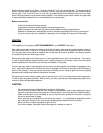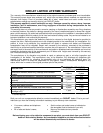
23
FREQUENTLY ASKED QUESTIONS
WHAT DO THE WORDS “DRAFT” AND “NEGATIVE PRESSURE” MEAN?
The word “draft” refers to the hot air movement that circulates in your stove’s exhaust system, moving
from the stove to the outside of the house, and carrying with it the combustion residues. The draft is a
natural phenomenon. Hot air weights less than cold air, causing it to rise. This is why the higher the
temperature in the exhaust system, the stronger the draft. It is also important to say that the “tunnel
effect” created by the exhaust system contributes to increase the draft effect. This is why chimneys that
are excessively long often create excessive draft, while chimneys that are abnormally short will have an
excessively low draft. The following are often symptoms of a draft problem:
- Excessively dirty (blackened) glass;
- A fire that has a tendency to die quickly when the stove door is closed;
- A stove that does not heat enough.
“Negative pressure” can be seen as a “reverse draft”. That is, air will circulate from the chimney toward
the interior of the house. Negative pressure is often what causes smoking problems. In general, negative
pressure is the result of either one or a combination of the three factors explained below:
1- A cold chimney. Cold air, which is heavier than hot air, has a tendency to go down the chimney
and create the effect of a “clog”. This explains why a stove that has not worked for a long time
and which chimney is very cold will sometimes be hard to light and cause smoking problems.
2- Negative pressure can also be caused by a “vacuum effect” in the room or the house. The air in a
house is constantly moving. Hot air rises, cold air moves down. Air can also be mechanically
expulsed outside of the house with the use of air-moving devices, such as a range hood, a air
exchanger, a dryer, a bathroom fan, etc. Furthermore, air goes in and out of the house through
cracks, doors, windows, etc. If air leaves a room without being replaced, a “vacuum effect” is
created. Therefore, if a house is well insulated and all windows are closed, the room will source its
air through the easiest alternative route, which is often your stove’s exhaust system. This creates
a negative pressure in your exhaust system. You now understand why it is often suggested that
a window be slightly open in the room where the stove is located. This enables the room to easily
source its air from outside the house without searching for an alternative route. The vacuum
effect can amplified when your stove is located in the basement. This is due to the fact that your
house itself acts like a chimney. Since hot air will rise to upper floors, it will “draw” air from the
basement of the house. This phenomenon is called the “chimney stack effect”.
3- Wind can also be a third cause of negative pressure. When your house is located near a
structure which height is superior to your roof’s, wind currents can create an interference with
your chimney, leading to negative pressure problems.
Drawings #1 to #5 starting on page 18 will help you understand the
explanations provided in this section.


















